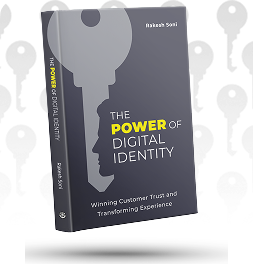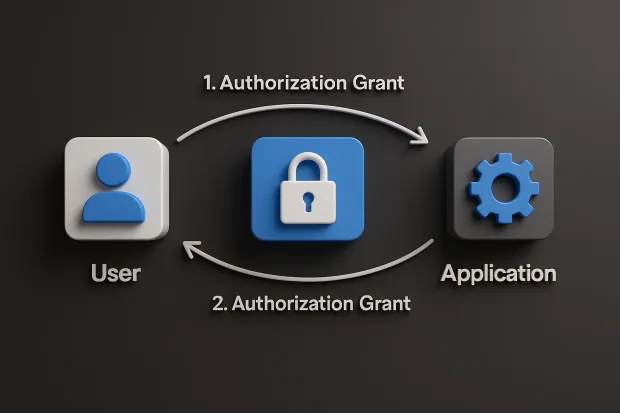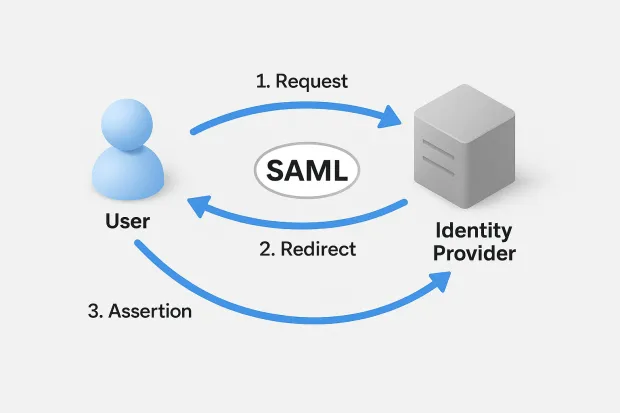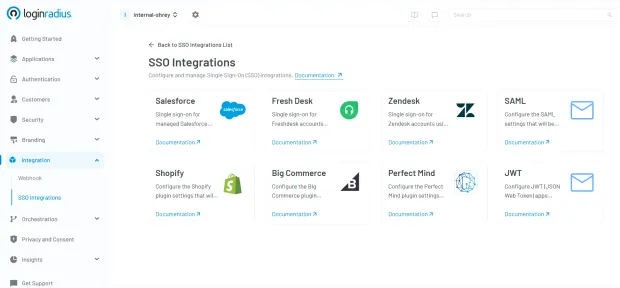SSO Authentication: Complete Guide to OpenID, SAML & OAuth
Learn how SSO authentication improves user experience, simplifies identity architecture, and scales securely with your business.


Learn How to Master Digital Trust

The State of Consumer Digital ID 2024

Top CIAM Platform 2024
Introduction
Imagine this: you're working on a tight deadline, trying to access a critical app, and bam, you're locked out because you forgot your password. Again. Now multiply that experience across five apps you use daily. This is the exact friction Single Sign-On (SSO) aims to eliminate.
In today’s digital-first world, users, whether employees, partners, or customers, juggle dozens of tools, platforms, and services. Managing separate credentials for each one is not just exhausting, it's a security risk. Enter SSO authentication, a mechanism that allows users to access multiple applications using a single set of credentials.
But what is single sign-on, and how does it work under the hood? This blog will break it all down from the types of SSO to how single sign-on works with industry-standard protocols like OpenID Connect, SAML, and OAuth.
We’ll also explore the single sign-on architecture powering secure and seamless access across environments, and how SSO links directly to IAM (Identity and Access Management), MFA (Multi-Factor Authentication), and broader sso security practices.
By the end of this blog, you’ll not only understand what single sign-on is but also how to choose the right SSO protocol for your stack and how LoginRadius makes implementation smoother for developers and IT teams alike.
Let’s decode SSO authentication once and for all.
What is Single Sign-On?
At its core, Single Sign-On (SSO) is exactly what it sounds like: a way for users to log in once and gain access to multiple applications or services without having to authenticate again each time.
Let’s say you log in to your company’s email system in the morning. Thanks to SSO, you can seamlessly access your file storage, project management tool, HR portal, and video conferencing platform, all without being prompted for another password. No repetitive logins. No password fatigue. No helpdesk calls for resets. Just a smooth, secure access experience.
That’s the beauty of SSO authentication.
Why SSO Matters More Than Ever
The average user today accesses 20 to 40 applications daily, especially in distributed workplaces or digital-first organizations. For IT teams, managing separate credentials for each tool creates chaos. For users, it's frustrating. For attackers, it's a playground.
Single Sign-On solves all three problems:
-
Users win with faster, frictionless logins.
-
IT teams win with centralized access control.
-
Security wins with fewer entry points to exploit.
In essence, SSO integration creates a centralized identity gateway: a trusted Identity Provider (IdP) handles the user authentication and shares that trust with multiple Service Providers (SPs) like Salesforce, Dropbox, Zoom, or your own custom apps.
Why SSO is a Must-Have Today
If you’re still wondering what SSO is or how single sign-on works, think of it as the key to: Simplifying logins for users, centralizing access for admins, and strengthening security across every app. And the best part? You don’t have to build it from scratch. Tools like LoginRadius offer out-of-the-box SSO authentication methods that work across social, enterprise, and B2B environments.

Overview of OpenID (OpenID Connect)
When people talk about logging in with Google, Apple, or Facebook, they’re almost always referring to OpenID Connect (OIDC). It’s one of the most developer-friendly ways to implement single sign-on authentication, especially in modern consumer-facing applications.
But before we go further, let’s clear up a common mix-up.
OpenID vs OpenID Connect: What’s the Difference?
-
OpenID (original) was an older protocol used for federated identity. It’s largely deprecated now.
-
OpenID Connect (OIDC) is the modern version built on top of OAuth 2.0, and widely adopted across web and mobile apps.
If you’re building anything new today, it’s OpenID Connect you’ll be working with.
How OpenID Connect Works in SSO
Think of OIDC as the identity layer that sits on top of OAuth. It authenticates the user and returns an ID token, often in the form of a JWT (JSON Web Token), containing user info like name, email, and unique ID.
Here’s what the flow typically looks like:
-
The user initiates login with a provider (like Google).
-
The app redirects the user to the Authorization Server (Google’s auth server).
-
After login, the Authorization Server sends back:
- An ID token (proving who the user is)
- An access token (if you requested access to APIs)
-
The app validates the tokens and starts the session.
And that’s how you get seamless login with no password created or stored on your app.
Security Considerations with OpenID
While OpenID Connect is secure when implemented correctly, it does rely heavily on proper token validation and HTTPS. Here are a few best practices:
-
Always validate the ID token signature and audience claim
-
Use short-lived tokens and refresh them securely
-
Avoid exposing tokens in URLs or insecure storage
SSO flows using OpenID Connect can be further hardened with MFA, device checks, and risk scoring, especially when implemented with a CIAM platform like LoginRadius.
How It Fits into Single Sign-On Architecture
In the grand scheme of single sign-on architecture, OpenID Connect serves as the bridge between user identity and your application ecosystem. You trust the identity proofing done by another provider (Google, Microsoft, Apple) and let users in without additional credentials.
It’s perfect for apps that want to offload login complexity while still maintaining control over access and personalization.

Overview of SAML (Security Assertion Markup Language)
If OpenID Connect is the new-age protocol powering modern apps and social logins, SAML is the enterprise veteran, robust, battle-tested, and still powering single sign-on authentication in thousands of organizations around the world.
Let’s break it down.
What is SAML?
SAML (Security Assertion Markup Language) is an XML-based standard used for exchanging authentication and authorization data between parties—primarily between an Identity Provider (IdP) and a Service Provider (SP).
It’s the backbone of enterprise SSO, particularly in environments where legacy systems, Active Directory, or enterprise SaaS apps like Salesforce, Zoom, or Workday are involved.
Where OpenID is JSON + mobile-friendly, SAML is XML + enterprise-focused.
How SAML Works in SSO
Here’s a simplified flow of how single sign-on works with SAML:
-
Request: The user tries to access an application (Service Provider).
-
Redirect: The app sends the user to the Identity Provider for authentication.
-
Assertion: Upon successful login, the Identity Provider sends back a SAML Assertion, an XML payload containing the user's identity and authorization details.
-
Session: The Service Provider validates the assertion and logs the user in.
When Should You Use SAML?
SAML is ideal when you need:
-
SSO across multiple enterprise apps
-
Seamless login experiences for internal employees
-
Integration with LDAP or Active Directory
-
A protocol trusted by IT compliance teams and regulators
It’s heavily used in industries like finance, government, healthcare, and education, where security and interoperability matter just as much as usability.
SAML and Security
One of the strongest points of SAML is that it keeps authentication logic centralized and off the application itself. That means:
-
No password database in each app
-
No separate user management
-
Strong encryption and signature validation via X.509 certificates
It also supports Just-in-Time (JIT) provisioning, meaning a new user can be automatically created in your system the moment their first SAML login happens.
All of this makes sso security with SAML extremely powerful and enterprise-grade.
Developer Note: Integration May Take Time
SAML is incredibly powerful, but it's also notoriously verbose and complex compared to OpenID or OAuth. Implementing SAML from scratch isn’t recommended unless you love parsing XML and decoding digital certificates.
Instead, most teams rely on platforms like LoginRadius or libraries like passport-saml, SAMLtool, or OneLogin’s SAML SDKs for integration. Here’s how easy it is to to configure SSO integrations in the LoginRadius admin console:

SAML in Single Sign-On Architecture
In a typical single sign-on architecture, SAML acts as the assertion pipeline that confirms who the user is and what they can access before that user ever touches your application.
It gives IT teams the ability to centrally manage identity, reduce login fatigue, and meet strict compliance requirements, all while offering users a seamless experience.
Overview of OAuth
So far, we’ve covered OpenID Connect for modern authentication and SAML for enterprise SSO, but what about OAuth? Chances are, if your app is interacting with APIs or integrating with third-party services, OAuth is already part of the picture.
But here’s the twist: OAuth isn’t actually an authentication protocol. It’s an authorization framework. And yet, it plays a major role in many SSO authentication flows.
What is OAuth?
OAuth 2.0 is a widely adopted standard that lets applications securely access resources on behalf of a user without sharing passwords.
Think of it like this:
You want to give a food delivery app access to your Google Calendar to check your availability, but you don’t want to hand over your Google password. OAuth makes that possible.
Instead of the user handing over their credentials, the app redirects the user to Google (the authorization server), and after successful consent, it gets a token that grants limited access (e.g., read-only calendar events).
How OAuth Works in SSO Scenarios
Although OAuth alone doesn’t authenticate users, it’s often combined with OpenID Connect (OIDC) to create an SSO experience, especially in web and mobile apps.
Here’s the general OAuth flow (simplified):
-
Authorization Request: The user tries to access an app, which redirects them to the Authorization Server.
-
Consent + Login: The user logs in (if needed) and consents to data access.
-
Authorization Grant: The Authorization Server sends back a code.
-
Access Token Exchange: The app exchanges the code for an Access Token (and optionally a Refresh Token).
-
Resource Access: The app uses the token to access APIs or user data.
If OpenID Connect is layered on top, you also get an ID Token, which actually proves user identity.
When Should You Use OAuth?
OAuth shines in:
-
API access delegation
-
Machine-to-machine (M2M) authentication
-
Mobile and SPAs (Single Page Applications)
-
Third-party integrations
-
Customer-facing platforms where SSO also requires granular data scopes
If you’re building any kind of product where users link external accounts or services, OAuth is essential.
Security Considerations
OAuth is powerful but not foolproof. Here’s what to watch out for:
-
Always use short-lived tokens with refresh rotation
-
Validate redirect URIs to prevent open redirects
-
Implement PKCE for public clients (e.g., mobile apps)
-
Don’t confuse authentication (who the user is) with authorization (what they can do)
Also, make sure your implementation uses HTTPS everywhere and avoid storing tokens in local storage.
How OAuth Fits into SSO Authentication
While OAuth doesn’t natively provide single sign-on, it is often used in tandem with OIDC to enable SSO flows, particularly for consumer apps, SaaS tools, and mobile-first platforms.
What is the Difference Between OpenID, SAML, and OAuth?
By now, you’ve seen that OpenID Connect, SAML, and OAuth are all foundational protocols that can support single sign-on authentication, but they serve different purposes and are built for different eras and ecosystems.
Here’s a simple way to think about them:
-
OpenID Connect = authentication for modern web and mobile apps
-
SAML = authentication for enterprise and legacy systems
-
OAuth = secure authorization (not authentication), often layered with OpenID for SSO
Let’s break that down further.
OpenID Connect vs SAML vs OAuth 2.0
| Feature / Criteria | OpenID Connect (OIDC) | SAML 2.0 | OAuth 2.0 |
|---|---|---|---|
| Primary Function | Authentication (who the user is) | Authentication (who the user is) | Authorization (what the user can access) |
| Underlying Protocol | Built on OAuth 2.0, uses JSON + REST | Uses XML + SOAP, older architecture | Token-based authorization, JSON + REST |
| Token Format | ID Token in JWT format | SAML Assertion (verbose XML) | Access Token (Bearer token, optional refresh) |
| Login Flow | Token-based redirect + callback | Browser POST redirect + assertion | Authorization code exchange + optional consent |
| Common Use Cases | B2C login, mobile apps, SPAs, CIAM, social login | Enterprise SSO, internal tools, compliance systems | Third-party API access, M2M auth, delegated scopes |
| SSO Support | Full support | Full support | Requires an OpenID layer for true SSO |
| Multi-Factor Auth (MFA) Support | Easy integration with adaptive MFA | Common in enterprise flows | Handled externally, via Identity Layer |
| Session Management | Modern token/session handling via ID tokens | Centralized session control via IdP | Token-based session; no native login session |
| Mobile-Friendliness | Designed for mobile + SPAs | Not ideal for mobile/web hybrids | Excellent for mobile + API-first apps |
| Ease of Integration | Developer-friendly SDKs, easy to scale | Complex XML integration, more IT-heavy | Moderate complexity; requires careful token handling |
| Security Posture | Strong: JWT validation, PKCE, scopes, consent | Strong: Signed assertions, certificate validation | Depends on scopes, implementation, and token hygiene |
| User Consent / Granular Permissions | Fine-grained scopes + consent screen | Typically all-or-nothing | Scopes define specific resource access |
| Who Typically Uses It? | App developers, CIAM teams, startups | IT admins, security/compliance teams | API developers, integrators, platform engineers |
| Ideal For | Fast-moving teams building apps with modern SSO | Enterprises needing secure, centralized identity | Platforms that need secure API/data sharing |
How They Differ
-
Use OpenID Connect if you’re building a customer-facing app and want to offer secure login via social providers or external IdPs. It’s great for modern CIAM.
-
Use SAML if you're supporting enterprise SSO across internal tools, especially with AD or other legacy infrastructure.
-
Use OAuth 2.0 when you need delegated access to APIs, machine-to-machine integration, or app-to-service authorization.
In most real-world sso integration use cases, you’ll see these combined:
-
OAuth + OIDC for user login + data access
-
SAML + MFA for enterprise-grade security
-
Federated IdPs where OpenID and SAML coexist
Choosing the Right Protocol for Your SSO Implementation
By now, you know that OpenID Connect, SAML, and OAuth 2.0 each serve a unique role in the SSO ecosystem. But the big question is: Which one should you use?
The answer isn’t one-size-fits-all. Your ideal protocol depends on your audience, tech stack, security needs, and the type of application you're building.
Let’s walk through a practical breakdown.
If You’re Building a Customer-Facing (B2C) Application:
-
Go with OpenID Connect (OIDC).
-
Why? It’s lightweight, mobile-friendly, and ideal for social login, single-page apps, and smooth onboarding experiences.
-
LoginRadius, Google, Microsoft, and others offer ready-made OIDC flows you can plug into your CIAM strategy.
Use cases: → SaaS platforms, fintech apps, eCommerce portals, streaming services
If You’re Supporting Enterprise Users or Internal Tools:
-
Use SAML 2.0.
-
Why? It’s trusted, secure, and integrates deeply with Active Directory, LDAP, and other enterprise IdPs.
-
SAML is the standard in regulated industries where IT departments demand fine-grained control.
Use cases: → HR systems, intranets, healthcare software, finance apps, B2B portals
If You’re Connecting APIs or Third-Party Services:
-
Choose OAuth 2.0 and add OpenID Connect if authentication is needed.
-
Why? OAuth is the gold standard for delegated access, API authorization, and machine-to-machine authentication.
Use cases: → IoT platforms, developer integrations, partner APIs, workflow automation
What If You Need All Three?
That’s more common than you think, especially in hybrid platforms that serve multiple user types.
A modern SSO integration strategy might include:
-
OpenID Connect for customers
-
SAML for enterprise partners or employee access
-
OAuth for connecting to third-party tools and APIs
With a platform like LoginRadius, you don’t have to choose just one. You can build a flexible SSO authentication setup that adapts to your users, not the other way around.
Choosing the right protocol isn’t just a technical decision; it’s a product and user experience decision. The right setup can reduce login fatigue, prevent security vulnerabilities, and accelerate user onboarding across platforms.
IAM Isn’t Just About Control, It’s About Experience
Modern identity is not just a security tool. It’s a business enabler.
-
SSO improves product experience for your users
-
SSO reduces administrative overhead for your IT team
-
SSO lays the foundation for zero-trust, compliance, and intelligent orchestration
In other words, the best IAM systems start with SSO and scale from there.
Conclusion
If you’ve made it this far, you’ve likely realized that Single Sign-On (SSO) is more than just a login shortcut; it’s the access gateway to a safer, smarter, and more scalable digital experience.
Whether you're building a B2C product that prioritizes onboarding speed, a B2B platform that needs secure partner access, or an internal IT ecosystem looking to reduce friction and strengthen governance, SSO should be your first move.
Where LoginRadius Fits In
Implementing secure and flexible SSO can be hard unless you have the right platform.
LoginRadius gives you:
-
Developer-friendly APIs and SDKs for OpenID, OAuth, and SAML
-
Built-in support for social login, B2B federation, and adaptive MFA
-
Hosted login pages and custom branding tools
-
Centralized IAM, provisioning, access policies, and session management
-
Regional data residencyand compliance-ready infrastructure
Whether you're starting fresh or replacing a legacy identity system, LoginRadius helps you build an SSO solution that scales with your business and doesn’t lock you into rigid workflows.
But only if it’s done right with the right protocols, the right architecture, and the right platform to support your identity evolution.
Get started with LoginRadius today- Talk to an identity expert.
FAQs
1. Which protocol is best for enterprise SSO?
A: SAML 2.0 is widely considered the best fit for enterprise SSO. It integrates smoothly with systems like Active Directory, supports Just-in-Time provisioning, and meets strict compliance and governance requirements often found in large organizations.
2. What are the advantages of using OpenID Connect over SAML?
A: OpenID Connect (OIDC) is more lightweight, developer-friendly, and designed for modern web and mobile apps. It uses JSON and REST APIs (instead of XML), making it faster to implement, easier to debug, and more compatible with today’s CIAM use cases.
3. Is OAuth the same as OpenID?
A: Not exactly. OAuth 2.0 is a framework for authorization, while OpenID Connect is a protocol for authentication that runs on top of OAuth. OAuth lets apps access data on behalf of a user; OpenID proves who the user is.

Featured Posts
SaaS Identity & Access Management: Multi-Tenant Best Practices
Why Most Mobile Apps Fail at Authentication (and How to Fix It)
Improve User Experience with Single Sign-On in Salesforce
WordPress Social Login: Simplify Sign-Ups in One Click
SSO Authentication: Complete Guide to OpenID, SAML & OAuth
A Developer’s Guide to Centralized Identity Management
TOTP Authentication Explained: How It Works, Why It’s Secure
Advantages of Time-Based One-Time Passwords (TOTP)
JWT Authentication with LoginRadius: Quick Integration Guide
Complete Guide to JSON Web Token (JWT) and How It Works
A comprehensive guide to OAuth 2.0
How Chrome’s Third-Party Cookie Restrictions Affect User Authentication?
How to Implement OpenID Connect (OIDC) SSO with LoginRadius?
Testing Brute-force Lockout with LoginRadius
Breaking Down the Decision: Why We Chose AWS ElastiCache Over Redis Cloud
LoginRadius Launches a CLI for Enterprise Dashboard
How to Implement JWT Authentication for CRUD APIs in Deno
Multi-Factor Authentication (MFA) with Redis Cache and OTP
Introduction to SolidJS
Why We Re-engineered LoginRadius APIs with Go?
Why B2B Companies Should Implement Identity Management
Top 10 Cyber Threats in 2022
Build a Modern Login/Signup Form with Tailwind CSS and React
M2M Authorization: Authenticate Apps, APIs, and Web Services
Implement HTTP Streaming with Node.js and Fetch API
NestJS: How to Implement Session-Based User Authentication
How to Integrate Invisible reCAPTCHA for Bot Protection
How Lapsus$ Breached Okta and What Organizations Should Learn
NestJS User Authentication with LoginRadius API
How to Authenticate Svelte Apps
How to Build Your Github Profile
Why Implement Search Functionality for Your Websites
Flutter Authentication: Implementing User Signup and Login
How to Secure Your LoopBack REST API with JWT Authentication
When Can Developers Get Rid of Password-based Authentication?
4 Ways to Extend CIAM Capabilities of BigCommerce
Node.js User Authentication Guide
Your Ultimate Guide to Next.js Authentication
Local Storage vs. Session Storage vs. Cookies
How to Secure a PHP API Using JWT
React Security Vulnerabilities and How to Fix/Prevent Them
Cookie-based vs. Cookieless Authentication: What’s the Future?
Using JWT Flask JWT Authentication- A Quick Guide
Single-Tenant vs. Multi-Tenant: Which SaaS Architecture is better for Your Business?
Build Your First Smart Contract with Ethereum & Solidity
What are JWT, JWS, JWE, JWK, and JWA?
How to Build an OpenCV Web App with Streamlit
32 React Best Practices That Every Programmer Should Follow
How to Build a Progressive Web App (PWA) with React
Bootstrap 4 vs. Bootstrap 5: What is the Difference?
JWT Authentication — Best Practices and When to Use
What Are Refresh Tokens? When & How to Use Them
How to Participate in Hacktoberfest as a Maintainer
How to Upgrade Your Vim Skills
Hacktoberfest 2021: Contribute and Win Swag from LoginRadius
How to Implement Role-Based Authentication with React Apps
How to Authenticate Users: JWT vs. Session
How to Use Azure Key Vault With an Azure Web App in C#
How to Implement Registration and Authentication in Django?
11 Tips for Managing Remote Software Engineering Teams
One Vision, Many Paths: How We’re Supporting freeCodeCamp
C## Init-Only Setters Property
Content Security Policy (CSP)
Implementing User Authentication in a Python Application
Introducing LoginRadius CLI
Add Authentication to Play Framework With OIDC and LoginRadius
React renderers, react everywhere?
React's Context API Guide with Example
Implementing Authentication on Vue.js using JWTtoken
How to create and use the Dictionary in C#
What is Risk-Based Authentication? And Why Should You Implement It?
React Error Boundaries
Data Masking In Nginx Logs For User Data Privacy And Compliance
Code spliting in React via lazy and suspense
Implement Authentication in React Applications using LoginRadius CLI
What is recoil.js and how it is managing in react?
How Enum.TryParse() works in C#
React with Ref
Implement Authentication in Angular 2+ application using LoginRadius CLI in 5 mins
How Git Local Repository Works
How to add SSO for your WordPress Site!
Guide to Authorization Code Flow for OAuth 2.0
Introduction to UniFi Ubiquiti Network
The Upcoming Future of Software Testers and SDETs in 2021
Why You Need an Effective Cloud Management Platform
What is Adaptive Authentication or Risk-based Authentication?
Top 9 Challenges Faced by Every QA
Top 4 Serverless Computing Platforms in 2021
QA Testing Process: How to Deliver Quality Software
How to Create List in C#
What is a DDoS Attack and How to Mitigate it
How to Verify Email Addresses in Google Sheet
Concurrency vs Parallelism: What's the Difference?
35+ Git Commands List Every Programmer Should Know
How to do Full-Text Search in MongoDB
What is API Testing? - Discover the Benefits
The Importance of Multi-Factor Authentication (MFA)
Optimize Your Sign Up Page By Going Passwordless
Image Colorizer Tool - Kolorizer
PWA vs Native App: Which one is Better for you?
How to Deploy a REST API in Kubernetes
Integration with electronic identity (eID)
How to Work with Nullable Types in C#
Git merge vs. Git Rebase: What's the difference?
How to Install and Configure Istio
How to Perform Basic Query Operations in MongoDB
Invalidating JSON Web Tokens
How to Use the HTTP Client in GO To Enhance Performance
Constructor vs getInitialState in React
Web Workers in JS - An Introductory Guide
How to Use Enum in C#
How to Migrate Data In MongoDB
A Guide To React User Authentication with LoginRadius
WebAuthn: A Guide To Authenticate Your Application
Build and Push Docker Images with Go
Istio Service Mesh: A Beginners Guide
How to Perform a Git Force Pull
NodeJS Server using Core HTTP Module
How does bitwise ^ (XOR) work?
Introduction to Redux Saga
React Router Basics: Routing in a Single-page Application
How to send emails in C#/.NET using SMTP
How to create an EC2 Instance in AWS
How to use Git Cherry Pick
Password Security Best Practices & Compliance
Using PGP Encryption with Nodejs
Python basics in minutes
Automating Rest API's using Cucumber and Java
Bluetooth Controlled Arduino Car Miniature
AWS Services-Walkthrough
Beginners Guide to Tweepy
Introduction to Github APIs
Introduction to Android Studio
Login Screen - Tips and Ideas for Testing
Introduction to JAMstack
A Quick Look at the React Speech Recognition Hook
IoT and AI - The Perfect Match
A Simple CSS3 Accordion Tutorial
EternalBlue: A retrospective on one of the biggest Windows exploits ever
Setup a blog in minutes with Jekyll & Github
What is Kubernetes? - A Basic Guide
Why RPA is important for businesses
Best Hacking Tools
Three Ways to do CRUD Operations On Redis
Traversing the realms of Quantum Network
How to make a telegram bot
iOS App Development: How To Make Your First App
Apache Beam: A Basic Guide
Python Virtual Environment: What is it and how it works?
End-to-End Testing with Jest and Puppeteer
Speed Up Python Code
Build A Twitter Bot Using NodeJS
Visualizing Data using Leaflet and Netlify
STL Containers & Data Structures in C++
Secure Enclave in iOS App
Optimal clusters for KMeans Algorithm
Upload files using NodeJS + Multer
Class Activation Mapping in Deep Learning
Full data science pipeline implementation
HTML Email Concept
Blockchain: The new technology of trust
Vim: What is it and Why to use it?
Virtual Dispersive Networking
React Context API: What is it and How it works?
Breaking down the 'this' keyword in Javascript
Handling the Cheapest Fuel- Data
GitHub CLI Tool ⚒
Lazy loading in React
What is GraphQL? - A Basic Guide
Exceptions and Exception Handling in C#
Unit Testing: What is it and why do you need it?
Golang Maps - A Beginner’s Guide
LoginRadius Open Source For Hacktoberfest 2020
JWT Signing Algorithms
How to Render React with optimization
Ajax and XHR using plain JS
Using MongoDB as Datasource in GoLang
Understanding event loop in JavaScript
LoginRadius Supports Hacktoberfest 2020
How to implement Facebook Login
Production Grade Development using Docker-Compose
Web Workers: How to add multi-threading in JS
Angular State Management With NGXS
What's new in the go 1.15
Let’s Take A MEME Break!!!
PKCE: What it is and how to use it with OAuth 2.0
Big Data - Testing Strategy
Email Verification API (EVA)
Implement AntiXssMiddleware in .NET Core Web
Setting Up and Running Apache Kafka on Windows OS
Getting Started with OAuth 2.0
Best Practice Guide For Rest API Security | LoginRadius
Let's Write a JavaScript Library in ES6 using Webpack and Babel
Cross Domain Security
Best Free UI/UX Design Tools/Resources 2020
A journey from Node to GoLang
React Hooks: A Beginners Guide
DESIGN THINKING -A visual approach to understand user’s needs
Deep Dive into Container Security Scanning
Different ways to send an email with Golang
Snapshot testing using Nightwatch and mocha
Qualities of an agile development team
IAM, CIAM, and IDaaS - know the difference and terms used for them
How to obtain iOS application logs without Mac
Benefits and usages of Hosts File
React state management: What is it and why to use it?
HTTP Security Headers
Sonarqube: What it is and why to use it?
How to create and validate JSON Web Tokens in Deno
Cloud Cost Optimization in 2021
Service Mesh with Envoy
Kafka Streams: A stream processing guide
Self-Hosted MongoDB
Roadmap of idx-auto-tester
How to Build a PWA in Vanilla JS
Password hashing with NodeJS
Introduction of Idx-Auto-Tester
Twitter authentication with Go Language and Goth
Google OAuth2 Authentication in Golang
LinkedIn Login using Node JS and passport
Read and Write in a local file with Deno
Build A Simple CLI Tool using Deno
Create REST API using deno
Automation for Identity Experience Framework is now open-source !!!
Creating a Web Application using Deno
Hello world with Deno
Facebook authentication using NodeJS and PassportJS
StackExchange - The 8 best resources every developer must follow
OAuth implementation with Node.js and Github
NodeJS and MongoDB application authentication by JWT
Working with AWS Lambda and SQS
Google OAuth2 Authentication in NodeJS - A Guide to Implementing OAuth in Node.js
Custom Encoders in the Mongo Go Driver
React's Reconciliation Algorithm
NaN in JavaScript: An Essential Guide
SDK Version 10.0.0
Getting Started with gRPC - Part 1 Concepts
Introduction to Cross-Site Request Forgery (CSRF)
Introduction to Web Accessibility with Semantic HTML5
JavaScript Events: Bubbling, Capturing, and Propagation
3 Simple Ways to Secure Your Websites/Applications
Failover Systems and LoginRadius' 99.99% Uptime
A Bot Protection Overview
OAuth 1.0 VS OAuth 2.0
Azure AD as an Identity provider
How to Use JWT with OAuth
Let's Encrypt with SSL Certificates
Encryption, Hashing & Salting: Your Guide to Secure Data
What is JSON Web Token
Understanding JSONP
Using NuGet to publish .NET packages
How to configure the 'Actions on Google' console for Google Assistant
Creating a Google Hangout Bot with Express and Node.js
Understanding End Of Line: The Power of Newline Characters
Cocoapods : What It Is And How To Install?
Node Package Manager (NPM)
Get your FREE SSL Certificate!
jCenter Dependencies in Android Studio
Maven Dependency in Eclipse
Install Bootstrap with Bower
Open Source Business Email Validator By Loginradius
Know The Types of Website Popups and How to Create Them
Javascript tips and tricks to Optimize Performance
Learn How To Code Using The 10 Cool Websites
Personal Branding For Developers: Why and How?
Wordpress Custom Login Form Part 1
Is Your Database Secured? Think Again
Be More Manipulative with Underscore JS
Extended LinkedIn API Usage
Angular Roster Tutorial
How to Promise
Learning How to Code
Delete a Node, Is Same Tree, Move Zeroes
CSS/HTML Animated Dropdown Navigation
Part 2 - Creating a Custom Login Form
Website Authentication Protocols
Nim Game, Add Digits, Maximum Depth of Binary Tree
The truth about CSS preprocessors and how they can help you
Beginner's Guide for Sublime Text 3 Plugins
Displaying the LoginRadius interface in a pop-up
Optimize jQuery & Sizzle Element Selector
Maintain Test Cases in Excel Sheets
Separate Drupal Login Page for Admin and User
How to Get Email Alerts for Unhandled PHP Exceptions
ElasticSearch Analyzers for Emails
Social Media Solutions
Types of Authentication in Asp.Net
Using Facebook Graph API After Login
Hi, My Name is Darryl, and This is How I Work
Beginner's Guide for Sublime Text 3
Social Network Branding Guidelines
Index in MongoDB
How to ab-USE CSS2 sibling selectors
Customize User Login, Register and Forgot Password Page in Drupal 7
Best practice for reviewing QQ app
CSS3 Responsive Icons
Write a highly efficient python Web Crawler
Memcached Memory Management
HTML5 Limitation in Internet Explorer
What is an API
Styling Radio and Check buttons with CSS
Configuring Your Social Sharing Buttons
Shopify Embedded App
API Debugging Tools
Use PHP to generate filter portfolio
Password Security
Loading spinner using CSS
RDBMS vs NoSQL
Cloud storage vs Traditional storage
Getting Started with Phonegap
Animate the modal popup using CSS
CSS Responsive Grid, Re-imagined
An Intro to Curl & Fsockopen
Enqueuing Scripts in WordPress
How to Implement Facebook Social Login
GUID Query Through Mongo Shell
Integrating LinkedIn Social Login on a Website
Social Provider Social Sharing Troubleshooting Resources
Social Media Colors in Hex
W3C Validation: What is it and why to use it?
A Simple Popup Tutorial
Hello developers and designers!
